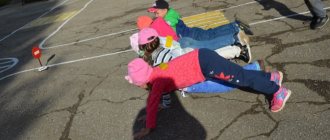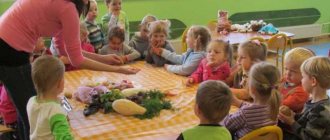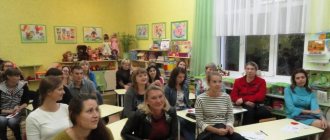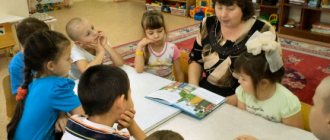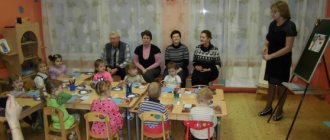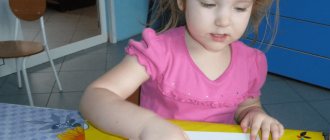The importance of individual work in the preparatory group of kindergarten
Individual work with children in a preschool educational institution (DOU) involves targeted pedagogical influence on the child, taking into account the characteristics of his psychophysical development. The goal of this work is to create the most favorable conditions for the further development and education of a preschooler.
Special attention is needed for students who, for some reason, lag behind the group (often absent from classes, slow, shy, too active) or, conversely, are ahead of other children in terms of the amount of material studied. For lagging preschoolers, individual lessons allow them to acquire knowledge and skills that correspond to the level of knowledge of the main group. The most common in preschool educational institutions are individual lessons with a speech therapist aimed at correcting sound pronunciation and teaching literacy. Children with mental development disorders (restless, unable to control attention, too impulsive or inhibited) need sessions with a psychologist.
Children with low self-esteem and problems in relationships with peers need special attention from teachers.
Individual developmental classes are also needed for pupils with outstanding abilities for any activity (singing, drawing, mathematics), as well as children with dominant cognitive interests. Diagnostic methods can be found in the work “Methodology for determining the dominance of a cognitive or play motive in the affective-need sphere of a child.”
How to identify a gifted child and organize work with him can be seen in the example of A. N. Mikova’s article “Individual route for the development of a gifted child,” which talks about working with a preschooler who has the ability to create words.
An individual approach to the work of a teacher is necessary. Taking into account the personal characteristics of each student will allow him to properly plan his work and ensure the fulfillment of the main objectives of educational activities. The basis of individual work is a comprehensive study of the level of psychophysical development, character traits, family atmosphere and living conditions of each pupil. Since pupils of the preparatory group (children aged 6–7 years) begin to gradually prepare for school and move away from play, it is important to teach them to learn: to perceive and assimilate information, to be attentive, to be persevering, and to be able to follow the rules and requirements of adults.
Objectives of individual lessons
Individual lessons with pupils of the preparatory group are aimed at solving the following tasks:
- development of dialogic and monologue speech (expanding vocabulary, improving the grammatical structure of speech);
- development of cognitive processes (attention, memory, thinking, visual and auditory perception);
- formation of prerequisites for educational activities (reading, writing, counting);
- development of general, fine and articulatory motor skills;
- maintaining and strengthening physical health;
- relieving psycho-emotional stress, teaching skills to constructively express negative emotions;
- increasing self-esteem and self-confidence.
Individual work can include from one to three students at a time if they have similar problems
Techniques for individual work that are relevant for children aged 6–7 years
Individual work with preschoolers is based on specifying the general goals of education, taking into account the personal characteristics of the child and the flexible use of methods and techniques of education aimed at creating the best conditions for the development of this particular child. The need for such work and its planning is based on the results of the teacher’s daily observations.
Individual work with preschoolers is carried out by a teacher (during group classes or in free time). Individual classes are conducted by educators or teachers with a narrow specialization: speech therapist, psychologist, defectologist, music worker, physical education teacher.
The following techniques can be used in individual training:
- individual interaction with a teacher or specialist (conducting an individual lesson, the organization of which may include any pedagogical methods appropriate for older preschool age);
- performing a task using an example, following the model of the teacher (during children’s independent activities, if the child does not succeed in something, the teacher demonstrates an algorithm of actions);
- performing according to a model or with the help of peers (you can create pairs or microgroups of children, where one of the pupils needs support; such an organization of work is also useful for the child playing the role of a teacher, since it teaches him the ability to explain and teach).
Requirements for organizing individual lessons
When organizing individual work, it is necessary to follow the principles of child personality development:
- Take into account the self-esteem of the preschooler. Children with low self-esteem are often passive, indecisive, and do not strive to actively participate in group activities. They need to be rewarded more often for correctly completed tasks. When organizing individual lessons, it is advisable to select tasks of adequate complexity so that the child feels confident in his abilities.
- To increase the effectiveness of classes, it is necessary to correctly determine which type of memory prevails in a child (visual, auditory or motor) and select exercises taking this into account, as well as develop other types of memory. Such diagnostics can be carried out using simple tests to determine in what situation the child remembers more words - when looking at pictures, listening or performing mechanical actions (for example, when coloring pictures).
- The complexity of the task is determined strictly individually: it should be within the child’s ability, but at the same time not be too simple. If this condition is met, individual work will become a good development stimulus for a preschooler. In practice, a teacher, preparing for a lesson, should have prepared tasks of different levels of complexity. The lesson begins with simple exercises, and then takes into account how the child was able to complete this work.
- The teacher should strive to organize the self-education of the preschooler. For this purpose, conversations are held with parents about creating conditions for raising and educating a child at home: how to organize a child’s work area, what activities and games help improve fine motor skills and speech development.
It is important to create an atmosphere of goodwill and acceptance of the child’s personality in the classroom.
The undeniable advantage of individual work is the personal contact of the teacher with the child, as a result of which not only educational and developmental tasks are solved, but also educational tasks.
Independent activity of children in the preparatory group
In the preparatory group of kindergarten, children are almost completely ready to enter school. Their thought processes, as well as voluntary processes, are already sufficiently formed to conduct independent educational activities under the guidance of a teacher.
Independent activity implies any form: physical activity, play activity, exploration of the surrounding world. But an adult must take into account the age characteristics of children. For example, the independent activity of children in the middle group is characterized by a high degree of curiosity, as well as the presence of play as a leading activity.
Let's try to understand the features of independent activity of children in the preparatory group of kindergarten. To begin with, let's look at the features of development at the age of 6 - 7 years:
- Voluntary regulation of behavior: perseverance, planning.
- Well-developed dialogue skills, developing the ability to build a monologue.
- Developed creative approach.
- Emerging self-esteem: the ability to self-criticize.
Methods for organizing independence skills in children 6-7 years old:
- Creating an environment adapted for independent activity.
- Development of knowledge, skills and abilities within the educational process.
- Development of children's motivation for independence.
Forms of organization:
- Independent play activity of children, where they interact with each other and use the means available to them.
- Artistic activity: creating images, designs.
- Theatrical activities: creating dramatizations, reading poetry to the public.
- Music lessons: singing, playing simple instruments.
Let's consider an example of organizing independent activities of children in the preparatory group of a kindergarten. Topic: “Different breeds of dogs.” The teacher talks about different breeds of dogs and shows them in pictures. Children are given the task of drawing the breed of dog that they liked the most. After the dog is drawn, each child presents his drawing, telling who is depicted in it, what is special about this breed and why he chose it. The teacher helps the children by asking leading questions during the performance.
Visit the website https://melkie.net to find out more extensive information about the independent activities of children in kindergarten. Independent activity in preschool educational institutions allows children to prepare for future studies at school. This preparation affects all aspects of the child’s development: physical and intellectual development, speech, level of social activity, artistic and aesthetic development.
Conducting individual lessons in the preparatory group of a preschool educational institution
The duration of an individual lesson in a preparatory group is no more than 30 minutes. The need for and number of classes is determined by the teacher and kindergarten specialists.
Table: time for individual work
| Time spending | Focus of classes |
| Morning time, first half of the day | Individual classes are conducted on cognitive development and correction of speech disorders. This time is also more suitable for classes with children to practice any movements if the preschooler does not have time to learn them with the whole group. Inactive and uncommunicative pupils can be given various assignments that require communication with adults and peers. To develop curiosity and cognitive activity, you can assign tasks to observe interesting phenomena (for example, the behavior of fish in an aquarium; how arriving birds peck food from a feeder in the kindergarten area; how drops begin under the warmth of the sun’s rays). |
| Afternoon | This part of the workday is more intended for the development of fine and gross motor skills: performing exercises on design, drawing, modeling, and practicing movements. |
| Walk | During walks, individual work is based on the selection of various exercises: some play with a ball to improve coordination of movements, others walk on stumps to develop balance, others step over obstacles or jump rope. Walking time is suitable for developing speech (learning tongue twisters, nursery rhymes, small games on word formation, solving riddles) and for improving mathematical knowledge (counting forward and backward, solving simple examples and problems). |
Throughout the day, the teacher finds the opportunity to provide an individual approach to each child.
Cyclogram of individual work
As an example, we can consider the cyclogram of individual work in the preparatory group:
- Communication with parents during the morning reception of preschoolers about issues of concern to them regarding the behavior or health of the child.
- Organizing a working and at the same time fun environment in the group, where each child can do something interesting to him (play, look through books, make crafts). When organizing independent activities for children, the teacher can instruct one of the preschoolers to help his friend complete an exercise (correctly assemble a mosaic or cut out a snowflake). Children with an introverted, timid or shy character require especially careful attention. Knowing the interests of such a child, the teacher can choose a suitable activity for him or include him in a game with other peers. Pupils who are overly active should be involved in activities that help reduce the level of excitement (drawing, designing).
- During meals, the teacher pays attention to the posture of his students: the back is straight, the legs are straight, the elbows are not placed on the table. And he also reminds the children about the rules for using cutlery: “Children, we hold the spoon in our right hand, the bread in our left. And the fork always points down.” Individual work is carried out in the form of encouraging children for neatness while eating, slowness, lack of talking and cultural skills (using a napkin). If someone has difficulties, the teacher shows the correct algorithm of actions. Children with poor appetite also need special attention and should be praised for eating their portion.
- After breakfast, individual lessons are organized for students who are lagging behind.
- A little preparatory work is carried out with indecisive children to increase their activity in a group lesson.
- Conducting a group lesson.
- When preparing a group for a walk, it is necessary to especially monitor frequently ill children so that they are dressed in accordance with the weather. At the same time, the skills of quickly and correctly dressing and the ability to tie shoelaces are reinforced.
- During the walk, in addition to interaction with the entire group of pupils, attention is also paid to individual work with individual children. These activities can have a different focus (physical exercise, work activity, learning short poems, tongue twisters).
- Before preparing for naptime, it is necessary to relieve increased arousal in overly active children.
- After afternoon tea until time for an evening walk, private lessons are organized.
- When handing over the child to the parents, the teacher tries to talk in detail about the child’s behavior during the day, his successes and problems, recommend literature, and also advise on other issues related to education.
The teacher monitors the condition of the pupils during the day and shares his observations with their parents
Table: topics of individual work in the preparatory group
| Lesson objectives | Exercises and games |
| Forming an idea of the accepted color designation of letters and sounds: vowels - red, voiceless consonants - green, voiced - blue. | Didactic game “I will become an excellent student.” |
| Development of the ability to perceive visual information. Formation of reading skills, sound analysis of words. | Didactic game “Counting and Reading”, lotto game “Reading”, lotto game “We played with the sound “K”. |
| Strengthening the correct pronunciation of sounds, the ability to correctly name vowels and consonants. | Speech therapy lotto: “Sound “R”, “Sound “Sh”, “Sound “L”. |
| Development of fine motor skills, imagination, perseverance. | Finger games, designing and cutting out paper, modeling, making images from puzzles and mosaics. |
| Formation of elementary mathematical representations (FEMP). | You can use the following games:
|
| Development of spatial imagination and coordination of movements. | Graphic dictations. |
| Development of logical thinking, ideas about the world around us. | You can use printed board games:
|
| Physical education and health work. | Individual work in PHYS has the same focus as the main classes; it is carried out with children who do not have time to master the movements and skills they are learning while working with a group:
|
| Development of musical and creative abilities. | Individual lessons with a music director can be conducted with one child or with a small subgroup of children. These classes can have different directions:
|
| Formation of environmental ideas. | Individual work on the topic “Ecology” for older preschoolers can be carried out as part of the organization of the “Young Naturalist” circle. The work of this circle may include:
|
It is necessary to take into account: if the child performs all the exercises of an individual lesson while in a sitting position, physical education should be held in the middle of the lesson.
During an individual lesson, one should not forget about alternating the child’s activities.
Examples of organizing individual lessons with preschoolers of the preparatory group
Classes with lagging children on cognitive development are conducted in a playful way, and it is very important to establish positive contact with the child. The teacher always welcomes the student and talks in an accessible way about what will happen in the lesson. Speech influence always evokes an emotional response in a preschooler, which contributes to the establishment of positive contact.
When conducting individual lessons with children in the preparatory group, you can use word games. Like any gaming activity, they create a positive emotional background and at the same time contribute to the improvement of speech, memory, attention, thinking, and broaden horizons. At the same time, these games do not require complex equipment and can be played both in a group and during walks. You need to start with simpler tasks, then the game conditions gradually become more complicated. For example, Maria Panshina, in the notes of an individual lesson aimed at developing verbal and logical thinking in the preparatory group, provides a detailed summary of all didactic games conducted with a preschooler.
You can motivate your child with a bright visual aid or picture. To increase motivation in an individual lesson, visual methods are used: showing pictures, objects, toys, observing natural phenomena (when conducting a lesson while walking). Here are some examples:
- Game “What profession are these tools for?”: select images of tools and corresponding images of people of various professions. The child must correctly identify pairs of pictures.
- Maria Ponomareva, in an article about an individual lesson with children of the preparatory group “Gifts of Autumn,” shows that to motivate a child, you can use an image made up of cubes. In this task, mistakes are made in the drawing characterizing autumn, and the preschooler must name what exactly does not correspond to the autumn season.
- The image can be used as a basis for discussion. For example: “Consider Ilya Mashkov’s still life “Bread.” What products are depicted by the artist in the picture?”
- To organize a lesson, you can use various stimulus materials: forms with tasks, layouts, cut-out pictures, the alphabet. An example of an individual lesson in a preparatory group on the topic “Correction of disorders in the development of attention” is given in the article by Oksana Zakelova.
Stimulus material is any objects, images, sounds and symbols necessary for testing.
Individual work uses a variety of didactic and gaming materials
To increase motivation, an individual lesson may include practical activities . This is especially important for children with increased cognitive interest. Preschoolers can be involved in conducting basic experiments with water, snow, air, sounds, light, magnets, magnifying glasses, and bulk materials.
Sometimes the lesson is organized as a magical journey to the land of knowledge, where interesting tasks and adventures can be encountered. Marina Durneva’s article “Individual speech therapy lesson for a 6-7 year old child” describes in detail how it can be organized.
Video: open individual speech therapy session
Video: fragment of an individual lesson with a psychologist
Video: individual music lesson
Game activity card index (preparatory group) on the topic
2. 3.Construction + plot-role-playing game “City Construction”Before organizing this game, I have a short conversation with the children: “Guys, what is the name of the city in which we live? That's right, Moscow. What and who do you usually see on the streets of Moscow? (various buildings, parks, public places, transport, many people). Where do you go with your parents other than kindergarten? (to the store, to the park, just walking down the street, to the zoo, to the circus). Fine. Now let's get creative and build our own small city (from a construction set). Let's think about what we will have in it? (at home, shop, park, kindergarten, school...). Okay, after building the city, the dolls that we find in our group will live in it.”
I start a game with the children. With them I determine the size of the future “city”, figure out where everything will be located and help the children assign roles, who will build what. I use pre-prepared equipment: signs with the inscriptions “School”, “Zoo”, “Circus”, “Kindergarten”, “Shop”.
During the construction process, I ask the children the names of the shapes of the parts. After the “city” is built, I help the children play with the construction: “These dolls will live in our city.” Girls will play as dolls, boys will play as toy characters that are in the group. I help develop the plot: the doll went to the store for groceries, then went to school to pick up the child, and on the day off she went with him to the circus.
At the end of the game I summarize: “Varya, Olya and Masha were the most active in building today. Nikita came up with the idea of where exactly to build the store, and Danila helped us distribute the characters among the houses in the city."
4. Didactic game “Fish, bird, beast”
I’m organizing a game: “Guys, now we’re going to play an interesting game. It’s called “Fish, Bird, Beast.” But first, tell me, what kind of fish do you know? birds? animals? (I repeat the names with the children) Okay. Now listen to the rules of the game. You stand in a circle. I will say “fish, bird, beast, fish, bird, beast, fish, bird, beast...” and point to each of you. As soon as I say one of these words and stop, the one I point to must name the fish, bird, or animal, depending on which word I stop on. If the word is “beast”, then you need to name any animal, “fish” - accordingly, a fish, and if “bird” - then a bird. But you must name it quickly and correctly, otherwise you will have to miss a move. Do you understand?"
I'm starting the game. During the game, I observe which of the children answers most quickly and confidently. Then I appoint the presenter in this way: “now the presenter will be (Olya), because she answered quickly and correctly several times.” This child becomes the leader. Then I will change the leader in the same way.
After the game, I give my assessment to the children: “I think (Olya) played the best today, she never made a mistake and answered correctly. Danila, Nikita and Varya also tried hard. And the rest of the guys just need to be a little more careful.”
5. Low mobility game “Be careful”
The game is new for the guys, so first I’ll explain the rules: “Guys, let’s play a new game now. It will require your attention. You need to perform the movements that I will name, but sometimes I myself will show completely different movements. For example, I will say: “Hands to the sides!”, And I will raise my hands up, etc. Your task, I repeat, is to show what I call “I play the game for 8-10 minutes, depending on the wishes of the children. At the end I give my assessment: “Varya and Olya were the most attentive. The others got lost more often, but that’s okay, we’ll play with you some more, and you’ll do better too.”
Planning individual work in the preparatory group
Each teacher, when drawing up a daily work plan, knows with which child and on what topic it is necessary to conduct an individual lesson. You can plan individual work as shown in the table.
Table: calendar planning of educational work in the preparatory group (fragment)
| Author | Ginyatova S.Z., teacher, MBDOU “Kindergarten of a combined type in groups for tubi-infected children N61”, Nizhnekamsk, Republic of Tatarstan. | ||||
| Integration of educational areas | Joint activities of adults and children, taking into account the integration of educational areas | Independent activities of children | |||
| Direct educational activities | Educational activities in special moments | ||||
| Group form of work | Individual form of work | ||||
| Morning |
|
| With Vladislav and Aliya, consolidate the ability to name numbers in forward and reverse order (oral counting). | Looking at soft toys. Ts.: continue to teach how to compose fairy tales about them. |
|
| GCD |
| Communication (Tat. language). | |||
| Hood. TV (drawing). Topic: "Kitten". | Help Elvira and Diana use a hard brush correctly. | |||
| Musical activity. | ||||
| PHYSICAL | ||||
| Walk |
| Tree watching. Ts.: note changes in the appearance of trees. | Learn the standing long jump technique with Vladik and Dasha. | Collective work at the nursery group site. Ts.: to cultivate hard work. | Outdoor game "Wolf in the Moat". Ts.: consolidate the rules of the game. |
| Evening |
| Reading A. Barto "Watch". Ts.: continue to teach how to analyze the heroes of works. |
| Conversation “What our city has for children.” Ts.: continue to teach children to talk about their hometown | Independent games for children. Ts.: Continue to teach children to organize their own leisure time. |
| Quote from: https://www.ivalex.vistcom.ru/konsultac771.html | |||||
The daily plan indicates individual work with a specific child.
When planning individual work, the teacher takes into account the level of development of certain abilities of each student
Card file of walks in the preparatory group for August
Card file of walks in the preparatory group for August
Card number 1 morning August
Integration of educational areas: social and communicative cognitive, speech, artistic and aesthetic, physical development.
Observation: weather conditions
Purpose: to give children an idea of the weather conditions in summer. Fix the name of the seasonal clothing.
Progress of observation: pay attention to the changes occurring in nature, note that the sun heats up more strongly in summer, so children walk naked. Ask if it is easy to look at the sun. Why can't you look at the sun? Note that during the day the sun is high; it’s hot outside; In the morning and evening the sun is low, so it becomes cooler. The day lasts long, and the nights are short and bright.
Literary word: summer is a ray of sunshine, warm rain from under the clouds. Summer - bright flowers of unusual beauty.
Outdoor game: No. 26 “Throw for the flag”
Didactic game: “Make a proposal about summer”
Goal: to consolidate the ability to compose a sentence with a given word.
Labor activity: build a sand slide
Goal: to develop labor skills.
Individual work: draw summer
Goal: develop observation skills. Memory.
Independent play activities of children.
Card No. 1 Evening
Integration of educational areas: social and communicative cognitive, speech, artistic and aesthetic, physical development.
Observation: bird watching.
Goal: to consolidate children's knowledge about birds
Progress of observation: pay attention to the arriving birds, remember what the birds are called, what they eat. Remember the names of sedentary and migratory birds.
Literary word: Signs of summer - if the rainbow soon disappears after the rain - the weather will be clear.
Outdoor game: No. 27 “Who will make the least jumps”
Didactic game: “Describe the bird”
Goal: learn to select adjectives for nouns.
Labor activity: cleaning the area from dry branches.
Goal: to develop labor skills.
Games with external material: games with cubes “Fold the pattern”
“Show where the birds are”
Goal: to develop thinking, spatial orientation.
Card number 2 morning
Integration of educational areas: social and communicative cognitive, speech, artistic and aesthetic, physical development.
Observation: insects, ladybug and ant
Goal: to introduce them to their way of life, the necessary conditions for life. Develop observation skills.
Progress of observation: in summer many insects appeared, including ants. Ants live in an anthill. Anthill is a multi-storey building with many apartments, storage rooms and bedrooms. All entrances and exits are guarded by soldier ants. From above, the ants make a covering of needles and twigs on the anthill, it protects the home from the vicissitudes of the weather, it is repaired and updated by working ants
Map of individual development of a preparatory group student
The new standard of education poses the task of individualizing the educational process. Each child needs to create the most favorable conditions for the development of his abilities and the unfolding of his creative potential. To solve this problem, it is necessary to know the personal and psychophysical characteristics of each child. To systematize information, it is proposed to use the “Individual Child Development Card,” which will reflect information about the preschooler, characterizing the features of his development throughout the entire period of his stay in the preschool educational institution.
Table: mapping the individual development of a preschooler
| Map sections | Information entered | Note |
| General information about the preschooler | The following information is entered in this section:
| This information is subject to change. |
| Diagnosis of child development | This section contains assessment information for each educational area, including:
| The assessment is carried out by the teacher based on observations of the child’s behavior in various situations. A scoring system can be developed, for example:
|
| Diagnostics of planned targets | Social-normative age characteristics of a child’s possible achievements, taken from the Education Standard, can be used as targets. | When conducting diagnostics, you can use the above three-point system. |
Currently, the principle of individualization of the educational process is one of the most important directions in the development of pedagogy at preschool educational institutions. A personal approach allows you to raise the quality of education to a new level. The organization of individual classes with preschoolers of the preparatory group makes it possible for the teaching staff of the preschool educational institution to prepare each kindergarten graduate for further educational activities.
